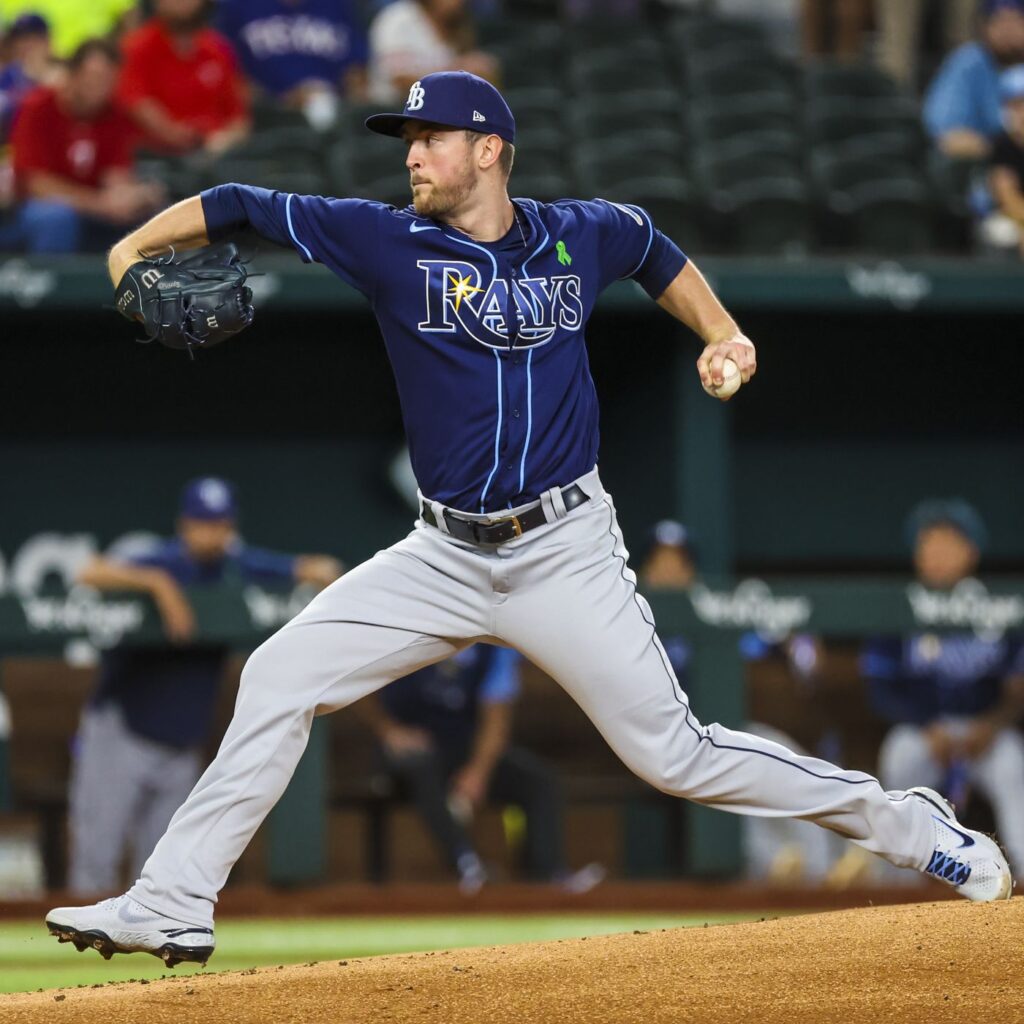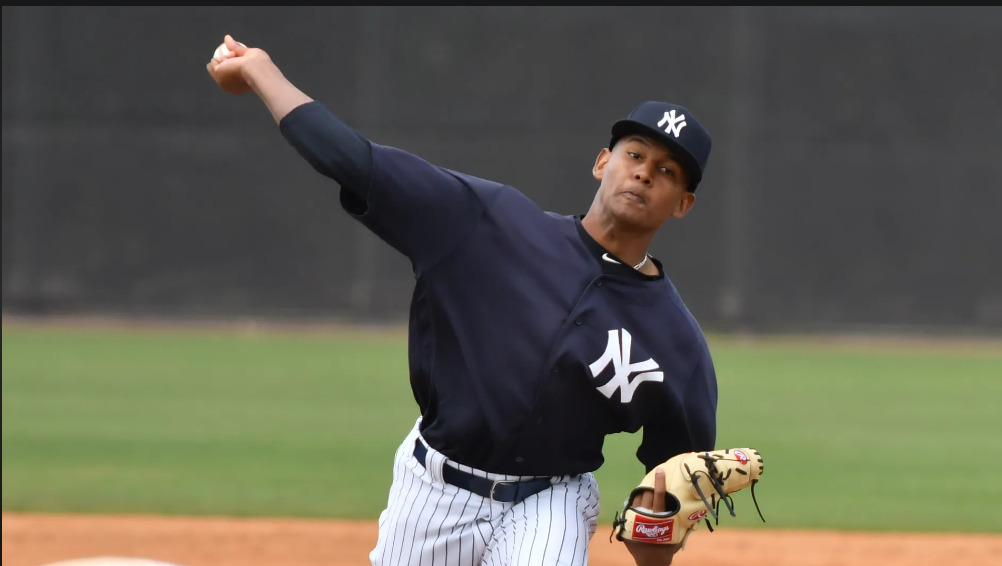Los lanzadores que deslumbraron en la primera semana de juegos en MLB
*Durante la primera semana de la temporada de la MLB, hemos visto por qué los lanzadores son más talentosos que nunca y les presentamos una prueba de ello.

Si bien nos han deslumbrado las actuaciones de estrellas como Shohei Ohtani y Gerrit Cole , ha habido otros lanzadores que demostraron que podrían estar dando un paso adelante. Ya sea una mejora en el material o el comando, una revisión del arsenal de lanzamiento o simplemente hacer su debut en Estados Unidos, ha habido una gran cantidad de lanzadores que se destacaron en sus primeras salidas de 2023.
Aquí hay algunos lanzadores que tuvieron buenos debuts y podrían estar preparados para dar grandes pasos hacia adelante en la temporada 2023.
Jeffrey Springs , Rays
6 IP, 0 H, 0 R, 1 BB, 12 K (2 de abril vs DET)
Springs fue una de las mayores sorpresas de la MLB la temporada pasada. Springs, una ex selección de la ronda 30 que cumplió 30 años en septiembre, encontró un hogar en Tampa Bay y fue uno de los mejores lanzadores abridores en una base de entrada por entrada en 2022. Su primera apertura de 2023, con un récord personal de 12 K’s, solo reafirmó la idea de que podría ser legítimo. El bullpen de los Rays finalmente no pudo terminar el juego sin hits combinado, pero eso no hizo que la actuación de Springs fuera menos emocionante. El zurdo registró un strike cantado o con swing en el 40,7% de sus lanzamientos, su mejor índice como abridor de Grandes Ligas. Al igual que el año pasado, Springs montó su cambio dominante hacia el éxito, generando bocanadas en nueve de 17 cambios en su contra.
Dylan Cease , White Sox
6.1 IP, 2 H, 1 R, 1 ER, 0 BB, 10 K (30 de marzo en HOU)
Cesar terminó segundo en la votación del premio AL Cy Young en 2022, por lo que no es una sorpresa que dominó el día inaugural . Lo que fue una sorpresa fue el excelente control de Cease después de que lideró las Mayores en bases por bolas (78) la temporada pasada. Por segunda vez en su carrera, Cease tuvo una salida en la que ponchó a 10 o más bateadores sin dar base por bolas. También lanzó strikes a un ritmo del 72,1 %, lo que la convierte en la segunda vez que lanza strikes más del 70 % de las veces en una apertura. Es solo un comienzo, pero si Cease da pasos significativos con el control de su material de élite, podríamos estar hablando de que ganará el premio Cy Young al final de esta tempora
Kodai Senga , Mets
5.1 IP, 3 H, 1 R, 1 ER, 3 BB, 8 K (2 de abril en MIA)
Senga fue uno de los mejores lanzadores del béisbol profesional nipón de Japón durante una década antes de unirse a los Mets en un cinco -año, contrato de $ 75 millones en la última temporada baja. Después de comenzar un poco inestable en su debut en la MLB contra los Marlins el domingo, Senga cambió el guión y dominó el resto de su salida. El material de Senga fue tan bueno como lo anuncian, resaltado por un cuatro costuras que promedió 96.8 mph y su horquilla fantasma de mediados de los 80, que es un lanzamiento único que funciona como un divisor. El último lanzamiento fue responsable de los ocho ponches de Senga y constantemente caía más de 30 pulgadas mientras generaba un quiebre en el brazo lateral. Los bateadores se adaptarán, pero está claro que las cosas desagradables de Senga juegan en la MLB.
Nick Lodolo, Reds
5 IP, 7 H, 2 R, 2 ER, 2 BB, 9 K (April 1 vs PIT)
After posting a 3.66 ERA and striking out 131 hitters in 19 starts as a rookie last year, Lodolo was already viewed as one of the most exciting young starting pitchers. The 25-year-old’s first start in 2023 only reaffirmed that belief. While his velocity was down a few mph, Lodolo dominated the Pirates by generating 22 swings-and-misses (45.8 percent of swings against him), both of which were career bests for a single game. His curveball was dominant as usual with a 59% whiff rate but it’s the progression of his changeup (four whiffs on six swings) that is even more exciting. After allowing a .336 expected batting average on his changeup last year, the pitch now looks like a real weapon that he can use to mitigate any platoon splits against right-handed hitters.
Pablo López, Twins
5.1 IP, 2 H, 0 R, 3 BB, 8 K (March 30 at KC)
Outside of bringing back Carlos Correa, acquiring López in the Luis Arraez trade represented the Twins’ biggest offseason move. López did not disappoint by tossing 5 1/3 scoreless innings in his Twins debut. Notably, López generated whiffs on 44.7% of his swings, the highest rate of any start in his career. The reason for more whiffs? López’s average fastball velocity was up from 92.7 mph in 2022 to 95 mph in his first start and his new sweeper generated whiffs on eight of 11 swings.

Freddy Peralta, Brewers
6 IP, 2 H, 0 R, 3 BB, 7 K (April 3 vs NYM)
This year’s Peralta looks much more like the dominant 2021 version who posted a 2.81 ERA and struck out 195 hitters in 144 1/3 innings. While Peralta was still quite good in 2022 (3.58 ERA in 78 IP), his stuff took a hit and led to a 6.5% decrease in strikeouts. In his first start of 2023, Peralta generated whiffs on 34.2% of swings and a 31.8% strikeout rate. Peralta’s uptick in whiffs was supported by his underlying pitch metrics. Both the four-seam fastball (+1.1 mph) and changeup (+3.8 mph) were thrown harder and much closer to his 2021 level while his curveball dropped (averaged 56 inches) like we haven’t seen since his 2018 debut season. It’s the slider that’s the most exciting though; he sacrificed three inches of vertical drop for an extra mph of velocity and an additional two inches of horizontal break that made it look like a nasty offering.
Reid Detmers, Angels
4.2 IP, 4 H, 3 R, 2 ER, 3 BB, 7 K (April 3 at SEA)
Detmers had command problems and issued too many walks in his 2023 debut, but it’s hard to ignore the uptick in stuff. Originally viewed as a safer, potential mid-rotation starting pitcher, Detmers showed up to Spring Training with a huge velocity increase in part due to his offseason work at places like Driveline. That velocity carried over into his season debut when his 95.3 mph average fastball velocity was 2.1 mph faster than last year while his slider (+3.7 mph), curveball (+1.8 mph), and changeup (+1.2 mph) also showed sizable velocity increases. As a result, Detmers now looks like a guy who can pair big-time stuff with the strong command that he’s shown in his professional career. If Detmers can maintain this stuff, the Angels could have one of the best starting rotations in the Majors.
Zach Eflin, Rays
5 IP, 3 H, 1 R, 1 ER, 1 BB, 5 K (April 1 vs DET)
Eflin’s three-year, $40 million deal over the offseason represented the largest free-agent deal in Rays franchise history. That investment is off to a good start for both the player and the team. Eflin allowed a lone run in his Rays debut, secured his first win in his new uniform, and made some changes to his pitch arsenal. Of note, Eflin doubled his changeup usage from last year to 12% and nearly doubled his cutter usage. Watch out for the changeup, a pitch that has never really been an out pitch for Eflin. In his first start, the 28-year-old righty added 3.2 inches of horizontal break to it, generating whiffs on five of six swings.
MacKenzie Gore, Nationals
5.1 IP, 3 H, 1 R, 1 ER, 4 BB, 6 K (April 2 vs ATL)
The 24-year-old Gore was one of many prospects sent to the Nationals in last summer’s Juan Soto trade, but he was injured at the time, delaying his Washington debut until Sunday. Gore’s early returns in 2023 are certainly encouraging. In his first start, the left-hander stifled a potent Braves lineup. While Gore will need to clean up the four walks he issued, he excelled in other areas. A third of the swings against Gore resulted in whiffs while just two of his batted balls were considered hard hit (95+ mph). A big reason for his strong start could be tied to Gore changing his breaking ball shape. Gore sacrificed a few inches of vertical drop on both his curveball and slider in exchange for roughly 1.5 mph of additional velocity and an extra inch of horizontal break.

Jhony Brito, Yankees
5 IP, 2 H, 0 R, 1 BB, 6 K (April 2 vs SF)
Injuries to Carlos Rodón, Luis Severino, and Frankie Montas created room in the Yankees rotation for someone else to step up. Enter Jhony Brito. The 25-year-old dazzled in his MLB debut. Brito, the Yankees’ 27th-ranked prospect entering the season per MLB Pipeline, was a relative unknown heading into Spring Training. Brito certainly opened some eyes Sunday with an electrifying pitch mix that included a mid-90s four-seam fastball and sinker along with a wicked changeup that generated whiffs on half of the 22 swings against it. Since the Yankees don’t need a fifth starter their next time through the rotation, Brito was optioned to Triple-A following his start but he’ll almost certainly be back in the big leagues soon.
Dylan Dodd, Braves
5 IP, 6 H, 1 R, 1 ER, 0 BB, 3 K (April 4 at STL)
It’s almost like the Braves know what they’re doing. In his first MLB start, Dodd pitched extremely well against a dangerous Cardinals lineup and picked up his first win. The Braves’ 10th-ranked prospect according to MLB Pipeline, Dodd poured in strikes at an elite 71.2% rate and showed a quality three-pitch mix. Dodd pounded the zone with fastballs and was able to expand with his slider and changeup, generating a combined 38% whiff rate on the latter two pitches. Given the Braves’ track record of strong player development and uncertainty around several of their starting pitchers, don’t be surprised if Dodd gets an extended look to show if this performance was legit.
